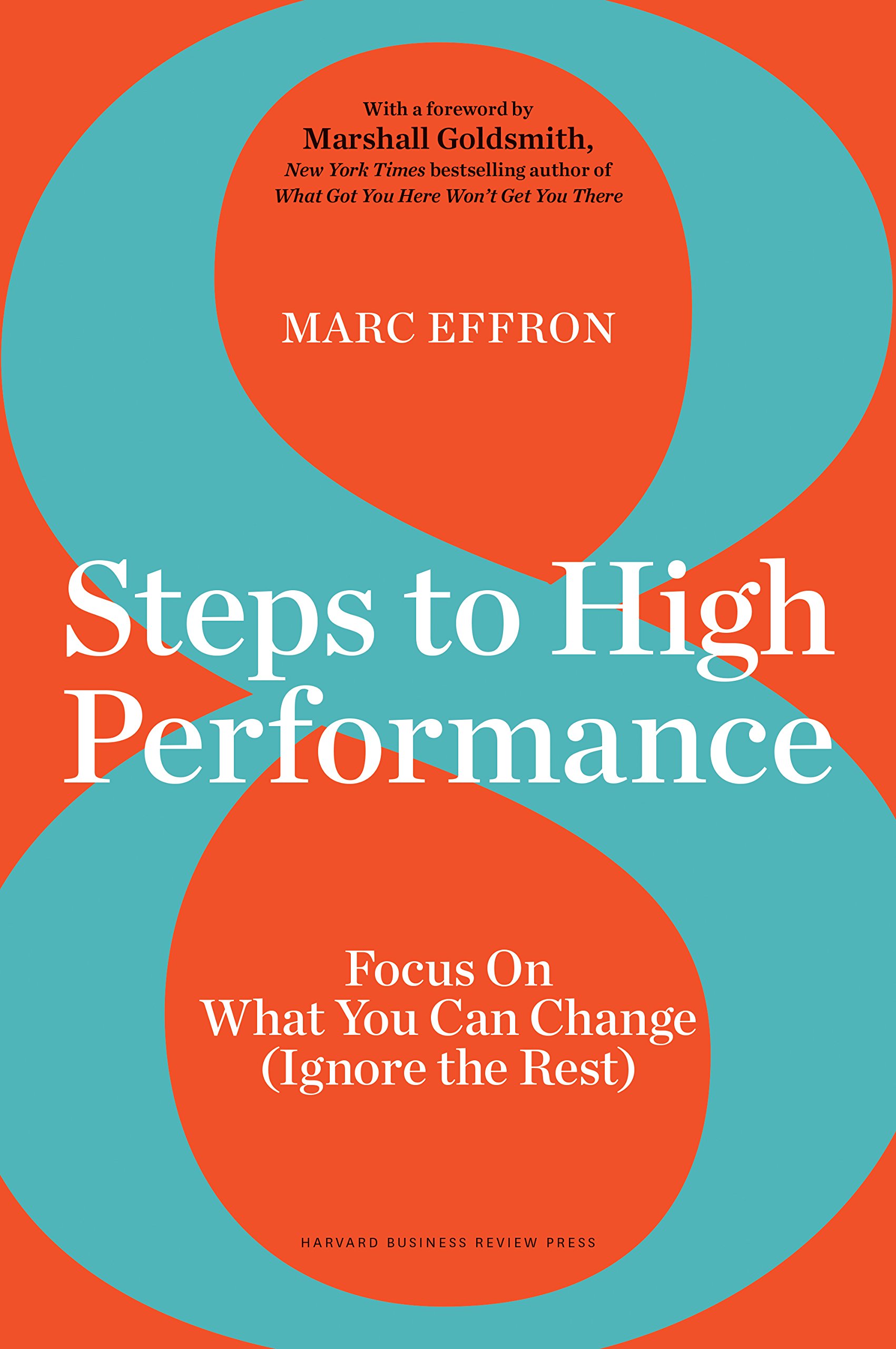 How can one perform optimally at work? According to talent consultant Marc Effron, the path to better performance is to focus on what you can change and not worry so much about the rest. In his book, 8 Steps to High Performance, Effron lays out his research-based guidelines on how to optimize your work performance. He is the founder of the Talent Strategy Group and publisher of Talent Quarterly magazine. Effron joined the Knowledge at Wharton show on SiriusXM recently to talk about his book. (Listen to the podcast at the top of this page.)
How can one perform optimally at work? According to talent consultant Marc Effron, the path to better performance is to focus on what you can change and not worry so much about the rest. In his book, 8 Steps to High Performance, Effron lays out his research-based guidelines on how to optimize your work performance. He is the founder of the Talent Strategy Group and publisher of Talent Quarterly magazine. Effron joined the Knowledge at Wharton show on SiriusXM recently to talk about his book. (Listen to the podcast at the top of this page.)
An edited transcript of the conversation follows.
Knowledge at Wharton: Performance in the workplace is something that every company focuses on. Is it the individual employee that ends up being responsible for it in most cases?
Effron: The individual employee, at the end of the day, is responsible for his or her own performance. And while we certainly hope our companies are going to help, hopefully we don’t outsource our performance to our employer.
… There are two things to think about if you want to be a higher performer. One, there are a lot of individual characteristics that we have — our intelligence, parts of our personality, things that are part of our upbringing, our background — that we really just can’t change. They either contribute to or detract from performance, and that is about 50% of what influences how successful we are at work. But the other 50% is completely controllable by us, and that’s what I lay out in the book. What does the hardcore academic science say is conclusively linked to higher individual performance at work? There are a few things that matter more than others.
… The no. 1 most powerful factor is setting fewer, bigger goals. The science around that is unbelievably strong — and it sounds so obvious. Most of us set goals at work, but what the science would say is most of us don’t stretch those goals anywhere near as much as we could. There is a ton of great science that says that we respond to bigger goals with more effort, meaning that most of the time a bigger goal is going to deliver a bigger result. But if we have 10 big goals, we’re going to kill ourselves. How do you focus on the few things that matter?
“I am a big fan of picking three really big, challenging goals.”
I am a big fan of picking three really big, challenging goals. One way of getting there is simply saying: What would it take to double last year’s performance? As ridiculous a sentiment as that might sound, it’s a great way to say, “I probably have to eliminate X or Y, or learn A or B.” It really focuses us on the big levers of contribution at work.
Knowledge at Wharton: How prevalent is the problem of having too many goals? We all have such hectic lives.
Effron: Absolutely. There is a difference between stuff that we have to do versus goals. We all have lots of stuff that we have to do. Even at work, there are 100 different things that our boss wants us to deliver. But there are likely, for most people, two, three, maybe four really significant contributions they are going to make, or can make, during the year. That is what your goal should be, and that is where most organizations get it wrong.
While this is a book about individual performance, our consulting firm works with some of the world’s largest global companies, and most are really horrible at goal-setting. One of the primary things that they do wrong is list 10, 12, 15 goals for some good, and some not so good, reasons.
Knowledge at Wharton: How did you come up with eight steps?
Effron: It started off with a long list of things that I thought might matter. I’ve always been a big student of the science of human performance. About two years ago, I [pondered], “Why isn’t there a book that simply consolidates everything we know is proven about human performance?” I couldn’t find one. So I started thinking, “What do I know from the science that’s true?
Then [I] proceeded to read about 2,000 academic articles. And [the content] really boiled it down to these eight factors that have the strongest proof [of effectiveness]. There are a lot of things that we take for granted that actually are not true, and I call that out in the last chapter on avoiding distractions.
“It is really important to keep an eye on where the company is going, and what capabilities I should have, to make me a high performer in the future.”
Knowledge at Wharton: Let’s go through some of these steps. You mentioned setting fewer big goals. “Behave to perform” is the next step. Are you saying that behaviors really do impact success?
Effron: Absolutely. Think of someone you know who is a great performer with bad behaviors. At some point, they are dragging those behaviors behind them like an anchor; that anchor is going to dig in, and it is going to halt their career. Behaving to perform isn’t necessarily about being a good corporate citizen. That is a great baseline; we should all be great corporate citizens. But [the key is] understanding which few behaviors to engage in that are really going to juice your performance.
While there is no one right model, there are a few models that have been studied and validated very well. We talk about transformational leadership and performance-driving leadership as another way of just getting a lot of work done. The challenge for a lot of employees is their company has a leadership model, a behavior model, and it’s probably filled with a lot of lovely stuff, but which of those behaviors really increases performance?
Knowledge at Wharton: Another step is, “Grow yourself faster,” which is interesting because growth is the ultimate goal for any company. But perhaps not enough people are thinking about personal growth?
Effron: Let’s draw a parallel. Would you ever set a growth goal that sounded something like, ‘We should sell more product’? That sounds a little bit vague. Yet if you look at most individual development plans, they say things like, “Be more strategic.” Part of the challenge, or part of the opportunity, is that if we structure our individual development plans with the same level of specificity that we structure our corporate growth and development plans, we would probably find it a lot easier to understand where we are today and where we need to be.
One of the things that we lay out in the book very clearly is, start with what I call the “from-to.” The from-to is a very basic way of saying, if Dan is our vice president, how do we want him to advance? ‘Dan, here is how we see you today; here is how we see you going forward.’ That level of crispness and clarity is absent in 98% of development plans around the world.
Knowledge at Wharton: Another step is “maximize your fit.” What does that mean?
Effron: Let’s talk about fit in two different contexts. There is fit as in [physical] fitness, and there is fit as in how you fit in with your organization.… Organizations are evolving faster than ever. As they evolve, they are going to have different capability needs…. It is really important to keep an eye on where the company is going, and what capabilities I should have, to make me a high performer in the future. Just because I am great at something today doesn’t mean that those same capabilities are going [to lead to my performing] great in the future.
“The challenge for a lot of employees is their company has a leadership model, a behavior model, and it’s probably filled with a lot of lovely stuff, but which of those behaviors really increases performance?”
Knowledge at Wharton: Aren’t there cases where a company should evolve around an employee who brings special or unique skills to the table?
Effron: That is probably a smaller number of folks than we might imagine because there aren’t so many folks with unique skillsets. But as an organization, should you be looking for unique, special talent who can add immediate value? Absolutely. Should you be flexible in how you structure their role? Absolutely.
Knowledge at Wharton: Another step is “Fake it.” Take us into that.
Effron: An excerpt from this chapter was published as LinkedIn’s Weekend Essay, and I spent most of the weekend responding to hundreds of angry comments about faking it and how horrible it is to do that.
[I’m simply pointing out] that companies change faster than people change. There are going to be times when we are going to need to behave in a way that does not feel comfortable. This is not about flexing your style a little bit or learning a new skill. This might be saying, “I’ve always worked in a very nice, calm environment. We are now in hyper-growth mode where I am going to need to lead people in a more aggressive way, make tougher people decisions. That is not me.” You can either say that is not me, which is a recipe for low performance, or you can say, “If I were going to be that person, what behaviors would I need to fake?”
Let’s say you are an actor being put into a different role. How would you need to act to be successful in that role? Faking doesn’t mean you are going to be a fake person or you are going to try to permanently change who you are. It is saying your company might have a unique need that demands that you behave in a unique way for a short period of time. You are going to be a higher performer if you learn how to fake that behavior for a while.
Knowledge at Wharton: You also talk about avoiding distractions, which seems to be impossible.
Effron: When you only have so many hours in the day, how many hours do you want to waste pursuing tactics that are simply not going to work? That is a challenge for a lot of folks who aren’t psychologists and who aren’t going to sort through all of this new material with a very skeptical eye.
If an eminent business school professor writes a book that says you are going to be a higher performer if you stand on your head, a decent number of people will start standing on their heads. The challenge is that behind a lot of these books is very little science. We talk about things like focusing on your strengths, authentic leadership, or other things that sound good in concept, but when you dig behind them there is just no science to back them up.
“Faking doesn’t mean you are going to be a fake person or you are going to try to permanently change who you are.”
Knowledge at Wharton: How do you see companies understanding these steps?
Effron: We work with a lot of large organizations around the world. I will use an example of a very large pharma company that has done a great job of transitioning from many goals to a few…. This organization had, as many pharma firms do, a massive innovation agenda. They realized that people were scattered in their approach to innovation, and they decided to have three big goals for everyone.
They said, “We know that means that a lot of things will fall off of your plate, but we are going to help people understand how to set big goals, help them to translate a lot of tasks and activities they do into something more meaningful, and we are going to hold them primarily responsible for just those three big things.”
Part of that is simply training people in how to do this better. It is not complicated, but people do need a bit of instruction. More importantly, it is holding them accountable. This is where it falls down in most companies — holding them accountable for the quality of those goals. Somebody has to look at those.
Knowledge at Wharton: But in the business culture today, companies want teams to work together on specific projects. How do you have collaboration and still focus on individual performance?
Effron: I probably need to have both individual goals and team-behavior goals. I am still an individual contributing to that team, and I should be held accountable for my individual contribution. But what I prefer to see instead of a team goal, although that is not harmful, is for people to be measured on good teaming behaviors. Am I collaborating with my team members? Am I sharing? Am I helping? Am I contributing ideas?
Knowledge at Wharton: How aware do you think people are in general about the strengths that they have?
Effron: We are all wonderfully delusional about our strengths and our weaknesses. The science is unbelievably clear that we are the least accurate observers of ourselves. Everyone around us knows us better than we know ourselves. That is why self-awareness is key. You are not going to be able to fit in with your company, you are not going to know what behaviors to focus on, unless you know where you stand today. How do people perceive you?
“We are all wonderfully delusional about our strengths and our weaknesses.”
For a lot of folks, that is really scary. I don’t want to ask because I don’t want to know. But a great starting place is that everybody can get better at just one thing. Why don’t I just ask some people I trust, “If I am going to be a better leader or manager or innovator, what is the one thing I might be able to do a little bit differently going forward?”
Knowledge at Wharton: Another step is “Connect.” Why is this an important component of success?
Effron: This tends to be the introvert’s Achilles heel. Introverts often are not naturally wired to connect with others. I find that when I work with folks who have a more introverted personality, they need a plan about how to do this both inside and outside the company.
One of the things we recommend in the book is to very clearly map out the strengths of your relationship in the company. Make a list of your key peers, of high performers above you and [give them a score] from 1 to 5 how strong your relationship is with them. For anybody who is a 3 or lower, you should have coffee or lunch with them just to get to know them. As uncomfortable as that might feel, I guarantee you are going to be a higher performer when you have a stronger network and people know more about you.
Knowledge at Wharton: What about external connections?
Effron: Again, science would suggest that people with a stronger external network are going to move faster through their careers for some very obvious reasons. That may feel uncomfortable, but there are lots of new ways of networking now. I am a massive introvert. LinkedIn has saved my life. It is really easy to make a fast friend there. Use tools like that if you are not naturally inclined to reach out. Also, most business leaders are fairly receptive if you reach out to them and say, for example, “Hey, I don’t know anything about materials engineering, and you are an expert in that. I would love just to spend a few minutes with you hearing more about how that field works.”
There are some other digital tools that can be very helpful, like sleep trackers. In our “Commit to Your Body” chapter, I talk about how the science is unbelievably clear that the quality and quantity of our sleep contributes to high performance at work. A tool as simple as a sleep tracker can be a meaningful tool to help you achieve higher performance.



